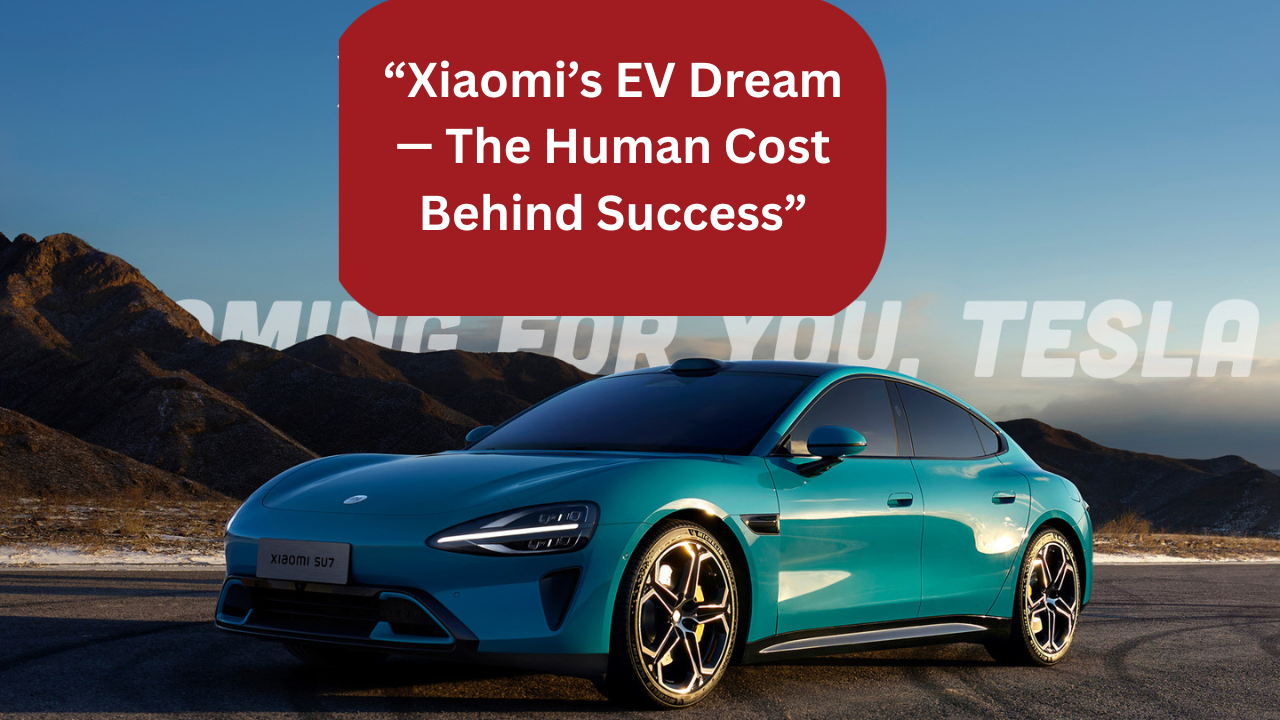Beijing: Xiaomi is racing to become China’s next electric vehicle (EV) giant. The tragic death of a 34-year-old worker in China’s fast-paced technology industry has prompted a nationwide debate about what happens when there is too much work.
In August 2024, Wang Peizhi had a heart attack while shopping with his son. He was the retail manager in charge of turning Xiaomi’s smartphone shops into EV showrooms. He died three days later. His death, officially deemed unrelated to work by local authorities, has nonetheless sparked outrage and questions about the company’s internal culture.
According to internal records reviewed by Bloomberg News, Wang managed at least 267 stores in just eight months, often working late into the night. After Xiaomi downsized its retail staff during the pandemic, Wang took on the workload of several employees.
His widow, Luna Liu, believes the company’s relentless push to meet its electric car rollout deadlines cost her husband his life.
“He was treated just like a leaf: when it falls, people step on it without noticing its existence,” Liu said in an interview.
From Smartphones to Sedans: A Ruthless Transition
Under billionaire co-founder Lei Jun, Xiaomi has poured over $1.6 billion into its EV ecosystem, from batteries and chips to assembly plants. Lei, who called this his “last entrepreneurial project,” vowed to make Xiaomi the first Chinese tech firm to succeed where Apple failed — building cars.
A cornerstone of that ambition was Wang’s department: Xiaomi’s EV retail network. The company’s plan involved converting hundreds of its mobile stores into showrooms for its flagship electric sedan, the SU7, priced around $30,000 — a direct rival to BYD’s Han L and Tesla’s Model 3.
As the EV launch neared, Wang’s workload intensified. He supervised high-profile sites, including Xiaomi’s flagship showroom near Tiananmen Square, while managing dozens of other ongoing projects. His WeChat logs show that he often sent work messages past 2:00 a.m.
“At one point, he was shouldering the workload of seven or eight people,” Liu said. “He was busy like a spinning top.”
The Price of Pressure
Despite health checkups and an active lifestyle, Wang’s long hours took a fatal toll. In the weeks before his death, he visited more than 80 stores across northern China with only two team members assisting him.
His final work messages reflected desperation and exhaustion. In one message, he wrote:
“What I signed up for was a life or death commitment. Don’t leave me hanging.”
Following his death, Xiaomi issued a statement expressing condolences and pledging support to Wang’s family. The company reportedly offered a 50,000-yuan hardship payment (around $7,000), which Liu says was never received.
Xiaomi denied any wrongdoing and insisted it complies with all labor laws. The Beijing Human Resources Bureau ruled that the case was not “work-related” under China’s strict guidelines, which only recognize deaths that occur within 48 hours of a work injury or medical treatment.
Workload and EV Expansion Collide
While Wang’s death brought attention to how Xiaomi works on the inside, the company kept expanding quickly into electric vehicles. Xiaomi had 370 EV stores in 125 places by August 2025, which helped it reach its goal of delivering 350,000 cars. There were 424 shops by October, but production was behind schedule, so people who wanted to buy an SU7 had to wait up to 48 weeks.
To close the gap, Xiaomi started trying a second-phase plant in Beijing that can make 150,000 cars a year. A third-phase plant will be able to make 450,000 cars a year. This increase in capacity made suppliers like CATL, Qualcomm, and Nvidia, which are all important parts of Xiaomi’s EV economy, a lot of money.
Deutsche Bank analysts think Xiaomi could make more than 50,000 electric vehicles each month by the end of 2025. This would put the company on track to deliver 400,000 to 500,000 vehicles in 2026.
A Broader Problem in China’s Tech Industry
Wang’s story echoes a widespread crisis across China’s technology sector, where employees routinely work under the infamous “996” schedule — 9 a.m. to 9 p.m., six days a week.
A 2024 poll by the job site Maimai found that Xiaomi employees worked an average of 11.5 hours per day, which was one of the longest workweeks in China’s tech scene. Companies like ByteDance, Meituan, and Tencent have been accused of doing the same thing.
People are upset about long work hours, and the government has promised to stop them, but the problem still exists. China’s labor rules say that people can only work 44 hours a week, but employers often let workers stay late. In 2024, the National Bureau of Statistics reported that Chinese workers worked an average of 49 hours per week, which was more than the global average.
Overwork deaths, particularly among young professionals, have triggered heated debates online. Cases at PDD Holdings and Bilibili prompted investigations and public outcry, but systemic change remains slow.
“These industries — AI, chips, EVs — are central to China’s national priorities,” said Mary Gallagher, a global affairs professor at the University of Notre Dame. “There’s enormous pressure in those places.”
Legacy and Lingering Questions
Inside Xiaomi, Wang’s death was briefly acknowledged in an internal meeting but reportedly led to no major changes in working conditions. Executives praised his efficiency in his performance reviews and promoted colleagues soon after.
Liu is still looking for someone to blame, even though he owes 550,000 yuan in debt and has a young son. She says that Xiaomi’s focus on speed and scale made it forget about its job to care for its employees.
“The work took all his time when he was needed as a father, as a husband,” she said. “Almost every time he came back from work, our son was already asleep.”
Xiaomi’s journey from smartphones to EVs has turned it into a symbol of China’s industrial ambition — but also a reminder of the human cost behind it. As the company eyes its next milestone, the story of Wang Peizhi stands as a silent warning: innovation built on exhaustion may come at too high a price.








